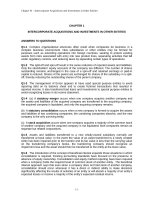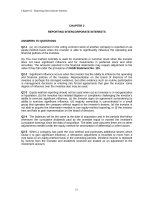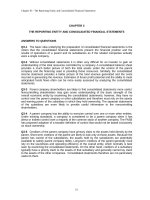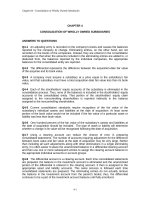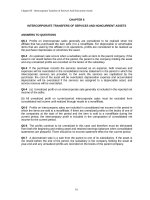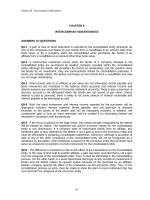Intermediate accounting 8th edition by spiceland sepe nelson thomas solution manual
Bạn đang xem bản rút gọn của tài liệu. Xem và tải ngay bản đầy đủ của tài liệu tại đây (1.16 MB, 101 trang )
Intermediate Accounting 8th edition by J. David Spiceland, James F. Sepe, Mark W. Nelson, Wayne B.
Thomas Solution Manual
Link full download test bank: />Link full download solution manual: />
Chapter 2. Review of the Accounting Process QUESTIONS
FOR REVIEW OF KEY TOPICS
Question 2–1
External events involve an exchange transaction between the company and a separate
economic entity. For every external transaction, the company is receiving something in exchange for
something else. Internal events do not involve an exchange transaction but do affect the financial
position of the company. Examples of external events are the purchase of inventory, a sale to a
customer, and the borrowing of cash from a bank. Examples of internal events include the recording
of depreciation expense, the expiration of prepaid rent, and the accrual of salary expense.
Question 2–2
According to the accounting equation, there is equality between the total economic resources
of an entity, its assets, and the claims to those resources, liabilities, and equity. This implies that,
since resources must always equal claims, the net effect of any transaction cannot affect one side of
the accounting equation differently than the other side.
Question 2–3
The purpose of a journal is to capture, in chronological order, the dual effect of a transaction. A
general ledger is a collection of storage areas called accounts. These accounts keep track of the
increases and decreases in each element of financial position.
Question 2–4
Permanent accounts represent the financial position of a company—assets, liabilities and
owners' equity—at a particular point in time. Temporary accounts represent the changes in
shareholders’ equity, the retained earnings component of equity for a corporation, caused by
revenue, expense, gain, and loss transactions. It would be cumbersome to record revenue/expense,
gain/loss transactions directly into the permanent retained earnings account. Recording these
transactions in temporary accounts facilitates the preparation of the financial statements.
Question 2–5
Assets are increased by debits and decreased by credits. Liabilities and equity accounts are
increased by credits and decreased by debits.
Solutions Manual, Vol.1, Chapter 2
2–1
Copyright © 2015 McGraw-Hill Education. All rights reserved. No reproduction or distribution without the prior written consent of
McGraw-Hill Education.
Answers to Questions (continued)
Question 2–6
Revenues and gains are increased by credits and decreased by debits. Expenses and losses are
increased by debits (thus causing owners’ equity to decrease) and decreased by credits (thus causing
owners’ equity to increase).
Question 2–7
The first step in the accounting processing cycle is to identify external transactions affecting
the accounting equation. Source documents, such as sales invoices, bills from suppliers, and cash
register tapes, help to identify the transactions and then provide the information necessary to process
the transaction.
Question 2–8
Transaction analysis is the process of reviewing the source documents to determine the dual
effect on the accounting equation and the specific elements involved.
Question 2–9
After transactions are recorded in a journal, the debits and credits must be transferred to the
appropriate general ledger accounts. This transfer is called posting.
Question 2–10
Transaction 1 records the purchase of $20,000 of inventory on account. Transaction 2 records a
credit sale of $30,000 and the corresponding cost of goods sold of $18,000.
Question 2–11
An unadjusted trial balance is a list of the general ledger accounts and their balances at a time
before any end-of-period adjusting entries have been recorded. An adjusted trial balance is prepared
after adjusting entries have been recorded and posted to the accounts.
2–2
Intermediate Accounting, 8/e
Copyright © 2015 McGraw-Hill Education. All rights reserved. No reproduction or distribution without the prior written consent of
McGraw-Hill Education.
Answers to Questions (continued)
Question 2–12
Adjusting entries record the effect on financial position of internal events, those that do not
involve an exchange transaction with another entity. They must be recorded at the end of any period
when financial statements are prepared to properly reflect financial position and results of operations
according to the accrual accounting model.
Question 2–13
Closing entries transfer the balances in the temporary owners’ equity accounts to a permanent
owners’ equity account, retained earnings for a corporation. This is done only at the end of a fiscal
year in order to reduce the temporary accounts to zero before beginning the next reporting year.
Question 2–14
Prepaid expenses represent assets recorded when a cash disbursement creates benefits beyond
the current reporting period. Examples are supplies on hand at the end of a period, prepaid rent, and
the cost of plant and equipment.
Question 2–15
The adjusting entry required when deferred revenues are earned is a debit to the deferred
revenue liability and a credit to revenue.
Question 2–16
Accrued liabilities are recorded when an expense has been incurred that will not be paid until a
subsequent reporting period. The adjusting entry required to record an accrued liability is a debit to
an expense and a credit to a liability.
Solutions Manual, Vol.1, Chapter 2
2–3
Copyright © 2015 McGraw-Hill Education. All rights reserved. No reproduction or distribution without the prior written consent of
McGraw-Hill Education.
Answers to Questions (continued)
Question 2–17
Income statement—The purpose of the income statement is to summarize the profit-generating
activities of the company during a particular period of time. It is a change statement that is reporting
the changes in owners’ equity that occurred during the period as a result of revenues, expenses,
gains, and losses.
Statement of comprehensive income—The purpose of the statement of comprehensive income
is to report the changes in shareholders’ equity during the reporting period that were not a result of
transactions with owners. This statement includes net income and also other comprehensive income
items.
Balance sheet—The purpose of the balance sheet is to present the financial position of the
company at a particular point in time. It is an organized array of assets, liabilities, and permanent
owners’ equity accounts.
Statement of cash flows—The purpose of the statement of cash flows is to disclose the events
that caused cash to change during the period.
Statement of shareholders’ equity—The purpose of the statement of shareholders’ equity is to
disclose the sources of the changes in the various permanent shareholders’ equity accounts that
occurred during the period. This statement includes changes resulting from investments by owners,
distributions to owners, net income, and other comprehensive income.
Question 2–18
A worksheet provides a means of organizing the accounting information needed to prepare
adjusting and closing entries and the financial statements. This error would result in an
overstatement of revenue and thus net income and retained earnings, and an understatement of
liabilities.
Question 2–19
Reversing entries are recorded at the beginning of a reporting period. They remove the effects
of some of the adjusting entries recorded at the end of the previous reporting period. This simplifies
the journal entries recorded during the new period by allowing cash payments or cash receipts to be
entered directly into the expense or revenue account without regard to the accrual recorded at the end
of the previous period.
2–4
Intermediate Accounting, 8/e
Copyright © 2015 McGraw-Hill Education. All rights reserved. No reproduction or distribution without the prior written consent of
McGraw-Hill Education.
Answers to Questions (concluded)
Question 2–20
The purpose of special journals is to record, in chronological order, the dual effect of repetitive
types of transactions, such as cash receipts, cash disbursements, credit sales, and credit purchases.
Special journals simplify the recording process in the following ways: (1) journalizing the
effects of a particular transaction is made more efficient through the use of specifically designed
formats; (2) individual transactions are not posted to the general ledger accounts, but are
accumulated in the special journals and a summary posting is made on a periodic basis; and (3) the
responsibility for recording journal entries for the repetitive types of transactions is placed on
individuals who have specialized training in handling them.
Question 2–21
The general ledger is a collection of control accounts representing assets, liabilities, permanent
and temporary shareholders’ equity accounts. The subsidiary ledger contains a group of subsidiary
accounts associated with a particular general ledger control account. For example, there will be a
subsidiary ledger for accounts receivable that will keep track of the increases and decreases in the
account receivable balance for each of the company’s customers purchasing goods or services on
credit. At any point in time, the balance in the accounts receivable control account should equal the
sum of the balances in the accounts receivable subsidiary ledger accounts.
Solutions Manual, Vol.1, Chapter 2
2–5
Copyright © 2015 McGraw-Hill Education. All rights reserved. No reproduction or distribution without the prior written consent of
McGraw-Hill Education.
BRIEF EXERCISES
Brief Exercise 2–1
Assets
1. + 165,000
2. –
40,000
3. +
200,000
–
120,000
4. + 180,000
–
180,000
5. – 145,000
=
Liabilities + Paid-in Capital + Retained Earnings
(inventory)
+ 165,000 (accounts payable)
(cash)
– 40,000 (expense)
+ 200,000 (revenue)
(accounts receivable)
(inventory)
– 120,000 (expense)
(cash)
(accounts receivable)
(cash)
– 145,000 (accounts payable)
Brief Exercise 2–2
1.
2.
3.
4.
5.
Inventory ..................................................................
Accounts payable.................................................
Salaries expense.......................................................
Cash .....................................................................
Accounts receivable.................................................
Sales revenue.......................................................
Cost of goods sold ...................................................
Inventory ..............................................................
Cash .........................................................................
Accounts receivable ............................................
Accounts payable ....................................................
Cash......................................................................
165,000
165,000
40,000
40,000
200,000
200,000
120,000
120,000
180,000
180,000
145,000
145,000
2–6
Intermediate Accounting, 8/e
Copyright © 2015 McGraw-Hill Education. All rights reserved. No reproduction or distribution without the prior written consent of
McGraw-Hill Education.
Brief Exercise 2–3
BALANCE SHEET ACCOUNTS
Cash
Accounts receivable
6/1 Bal.
4.
65,000
180,000
6/30 Bal.
60,000
6/1 Bal.
40,000
145,000
3.
2.
5.
6/30 Bal.
Inventory
6/1 Bal.
1.
0
165,000
6/30 Bal.
45,000
43,000
200,000
180,000
4.
63,000
Accounts payable
120,000
6/1 Bal.
5.
3.
145,000
6/30 Bal.
22,000
165,000
1.
42,000
INCOME STATEMENT ACCOUNTS
Sales revenue
Cost of goods sold
0
6/1 Bal.
200,000
3.
200,000
6/30 Bal.
6/1 Bal.
3.
6/30 Bal.
0
120,000
120,000
Salaries expense
6/1 Bal.
2.
0
40,000
6/30 Bal.
40,000
Solutions Manual, Vol.1, Chapter 2
2–7
Copyright © 2015 McGraw-Hill Education. All rights reserved. No reproduction or distribution without the prior written consent of
McGraw-Hill Education.
Brief Exercise 2–4
1.
2.
3.
Prepaid insurance.....................................................
Cash .....................................................................
Note receivable .......................................................
Cash .....................................................................
Equipment ...............................................................
Cash .....................................................................
12,000
12,000
10,000
10,000
60,000
60,000
Brief Exercise 2–5
1.
2.
Insurance expense ($12,000 x 3/12).............................
Prepaid insurance ................................................
Interest receivable ($10,000 x 6% x 6/12).....................
Interest revenue....................................................
3.
Depreciation expense...............................................
Accumulated depreciation – equipment ..............
3,000
3,000
300
300
12,000
12,000
Brief Exercise 2–6
Net income would be higher by $14,700 ($3,000 –300 + 12,000).
2–8
Intermediate Accounting, 8/e
Copyright © 2015 McGraw-Hill Education. All rights reserved. No reproduction or distribution without the prior written consent of
McGraw-Hill Education.
Brief Exercise 2–7
1.
4.
Service revenue .......................................................
Deferred service revenue ....................................
2.
Advertising expense ($2,000 x 1/2) .............................
Prepaid advertising ..............................................
3.
Salaries expense .......................................................
Salaries payable....................................................
Interest expense ($60,000 x 8% x 4/12).........................
Interest payable ....................................................
4,000
4,000
1,000
1,000
16,000
16,000
1,600
1,600
Brief Exercise 2–8
Assets would be higher by $1,000, the amount of prepaid advertising that expired during the
month. Liabilities would be lower by $21,600 ($4,000 + 16,000 +
1,600). Shareholders’ equity (and net income for the period) would
be higher by
$22,600.
Brief Exercise 2–9
1.
2.
3.
4.
Interest receivable ...................................................
Interest revenue ($50,000 x 6% x 9/12) ....................
Rent expense ($12,000 x 3/12) ....................................
Prepaid rent .........................................................
Supplies expense ($3,000 + 5,000 – 4,200)...................
Supplies ................................................................
Salaries and wages expense .....................................
Salaries and wages payable..................................
2,250
2,250
3,000
3,000
3,800
3,800
6,000
6,000
Solutions Manual, Vol.1, Chapter 2
2–9
Copyright © 2015 McGraw-Hill Education. All rights reserved. No reproduction or distribution without the prior written consent of
McGraw-Hill Education.
Brief Exercise 2–10
BOWLER CORPORATION
Income Statement
For the Year Ended December 31, 2016
Sales revenue ...............................................
Cost of goods sold .......................................
Gross profit .................................................
Operating expenses:
Salaries ......................................................
Rent ...........................................................
Depreciation .............................................
Miscellaneous ...........................................
Total operating expenses .............
Net income ..................................................
$325,000
168,000
157,000
$45,000
20,000
30,000
12,000
107,000
$ 50,000
2–10
Intermediate Accounting, 8/e
Copyright © 2015 McGraw-Hill Education. All rights reserved. No reproduction or distribution without the prior written consent of
McGraw-Hill Education.
Brief Exercise 2–11
BOWLER CORPORATION
Balance Sheet
At December 31, 2016
Assets
CurrentCash
assets:
...........................................................
$ 5,000
10,000
16,000
31,000
Accounts receivable ..................................
Inventory ...................................................
Total current assets ..............................
.................................................
PropertyEquipment
and equipment:
Less: Accumulated depreciation ...............
Total assets ........................................
100,000
(40,000)
60,000
$91,000
Liabilities and Shareholders' Equity
Accounts payable ......................................
Salaries payable ........................................
Total current liabilities ........................
$ 20,000
12,000
32,000
Current liabilities:
Common stock ..........................................
Shareholders’
equity:
Retained earnings
......................................
Total shareholders’ equity ...................
Total liabilities and shareholders’ equity
$50,000
9,000
59,000
$91,000
Solutions Manual, Vol.1, Chapter 2
2–11
Copyright © 2015 McGraw-Hill Education. All rights reserved. No reproduction or distribution without the prior written consent of
McGraw-Hill Education.
Brief Exercise 2–12
Sales revenue ..................................................................
Income summary.........................................................
850,000
Income summary.............................................................
Cost of goods sold ......................................................
815,000
850,000
580,000
180,000
40,000
15,000
Salaries expense ..........................................................
Rent expense ...............................................................
Interest expense...........................................................
Income summary($850,000 – 815,000) ..............................
Retained earnings .......................................................
35,000
35,000
Brief Exercise 2–13
Revenues
Expenses:
Salaries
Utilities
Advertising
Net Income
$428,000*
(240,000)
(33,000)**
(12,000)
$143,000
*$420,000 cash received plus $8,000 increase ($60,000 – 52,000) in amount due from
customers:
Cash ........................................................................
Accounts receivable (increase in account) ..............
Sales revenue (to balance) ...................................
420,000
8,000
428,000
** $35,000 cash paid less $2,000 decrease in amount owed to utility company:
Utilities expense (to balance) .................................
Utilities payable (decrease in account)....................
Cash .....................................................................
33,000
2,000
35,000
2–12
Intermediate Accounting, 8/e
Copyright © 2015 McGraw-Hill Education. All rights reserved. No reproduction or distribution without the prior written consent of
McGraw-Hill Education.
EXERCISES
Exercise 2–1
1.
2.
3.
4.
5.
6.
7.
8.
9.
Assets
+ 300,000
–
10,000
+
40,000
+
90,000
+ 120,000
–
70,000
–
5,000
–
6,000
+
6,000
–
70,000
+
55,000
–
55,000
–
1,000
=
(cash)
(cash)
(equipment)
(inventory)
Liabilities + Paid-in Capital + Retained Earnings
+ 300,000 (common stock)
+ 30,000 (note payable)
+ 90,000 (accounts payable)
(accounts receivable)
(inventory)
(cash)
+ 120,000
– 70,000
–
5,000
(revenue)
(expense)
–
(expense)
(expense)
(cash)
(prepaid insurance)
(cash)
- 70,000 (accounts payable)
(cash)
(accounts receivable)
(accumulated depreciation)
1,000
Solutions Manual, Vol.1, Chapter 2
2–13
Copyright © 2015 McGraw-Hill Education. All rights reserved. No reproduction or distribution without the prior written consent of
McGraw-Hill Education.
Exercise 2–2
1.
2.
3.
4.
5.
6.
7.
8.
9.
Cash..........................................................................
Common stock .....................................................
Equipment ................................................................
Note payable ........................................................
Cash .....................................................................
Inventory ..................................................................
Accounts payable.................................................
Accounts receivable.................................................
Sales revenue.......................................................
Cost of goods sold ...................................................
Inventory ..............................................................
Rent expense ............................................................
Cash......................................................................
Prepaid insurance.....................................................
Cash......................................................................
Accounts payable.....................................................
Cash......................................................................
Cash..........................................................................
Accounts receivable.............................................
Depreciation expense...............................................
Accumulated depreciation ...................................
300,000
300,000
40,000
30,000
10,000
90,000
90,000
120,000
120,000
70,000
70,000
5,000
5,000
6,000
6,000
70,000
70,000
55,000
55,000
1,000
1,000
2–14
Intermediate Accounting, 8/e
Copyright © 2015 McGraw-Hill Education. All rights reserved. No reproduction or distribution without the prior written consent of
McGraw-Hill Education.
Exercise 2–3
3/1 Bal.
1.
8.
3/31 Bal.
BALANCE SHEET ACCOUNTS
Cash
Accounts receivable
0
300,000
55,000
10,000
5,000
2.
5.
6,000
70,000
6.
3/1 Bal.
4.
0
120,000
3/31 Bal.
65,000
Inventory
0
,
90 000
3/31 Bal.
20,000
Prepaid insurance
70,000
4.
Equipment
3/1 Bal.
3/1 Bal.
6.
0
,
6 000
3/31 Bal.
6,000
Accumulated depreciation
0
0
2.
40,000
1,000
3/31 Bal.
40,000
1,000
Accounts payable
7.
70,000
8.
7.
264,000
3/1 Bal.
3.
55,000
3/1 Bal.
9.
3/31 Bal.
Note payable
0
90,000
3/1 Bal.
3.
0
30,000
3/1 Bal.
2.
20,000
3/31 Bal.
30,000
3/31 Bal.
Common stock
0
300,000
300,000
3/1 Bal.
1.
3/31 Bal.
Solutions Manual, Vol.1, Chapter 2
2–15
Copyright © 2015 McGraw-Hill Education. All rights reserved. No reproduction or distribution without the prior written consent of
McGraw-Hill Education.
Exercise 2–3 (concluded)
INCOME STATEMENT ACCOUNTS
Sales revenue
Cost of goods sold
0
3/1 Bal.
120,000
4.
120,000
3/31 Bal.
3/1 Bal.
0
4.
70,000
3/31 Bal.
70,000
Rent expense
3/1 Bal.
0
Depreciation expense
5.
5,000
3/1 Bal.
9.
3/31 Bal.
5,000
3/31 Bal.
Account Title
Cash
Accounts receivable
Inventory
Prepaid insurance
Equipment
Accumulated depreciation
Accounts payable
Note payable
Common stock
Sales revenue
Cost of goods sold
Rent expense
Depreciation expense
Totals
0
1,000
1,000
Debits
264,000
65,000
20,000
6,000
40,000
Credits
1,000
20,000
30,000
300,000
120,000
70,000
5,000
1,000
471,000
471,000
2–16
Intermediate Accounting, 8/e
Copyright © 2015 McGraw-Hill Education. All rights reserved. No reproduction or distribution without the prior written consent of
McGraw-Hill Education.
Exercise 2–
17 1. Cash ......................................................................
2.
3.
4.
5.
6.
7.
8.
9.
10.
11.
Common stock ...................................................
Furniture and fixtures...........................................
Cash ...................................................................
Note payable .....................................................
Inventory ..............................................................
Accounts payable...............................................
Accounts receivable .............................................
Sales revenue.....................................................
Cost of goods sold................................................
Inventory............................................................
Rent expense ........................................................
Cash ...................................................................
Prepaid insurance .................................................
Cash ...................................................................
Accounts payable .................................................
Cash ...................................................................
Cash ......................................................................
Accounts receivable...........................................
Retained earnings .................................................
Cash ...................................................................
Depreciation expense ...........................................
Accumulated depreciation.................................
Insurance expense ($3,000 ÷ 12 months)..................
Prepaid insurance...............................................
500,000
500,000
100,000
40,000
60,000
200,000
200,000
280,000
280,000
140,000
140,000
6,000
6,000
3,000
3,000
120,000
120,000
55,000
55,000
5,000
5,000
2,000
2,000
250
250
Solutions Manual, Vol.1, Chapter 2
2–17
Copyright © 2015 McGraw-Hill Education. All rights reserved. No reproduction or distribution without the prior written consent of
McGraw-Hill Education.
Exercise 2–
List A
18k 1. Source
documents
e
2.
a
3.
j
4.
f
5.
b
6.
h
7.
c
8.
d
9.
g 10.
i 11.
List B
a. Record of the dual effect of a transaction in
debit/credit form.
Transaction analysis
b. Internal events recorded at the end of a
reporting period.
Journal
c. Primary means of disseminating information to
external decision makers.
Posting
d. To zero out the owners’ equity temporary
accounts.
Unadjusted trial balance e. Determine the dual effect on the accounting
equation.
Adjusting entries
f. List of accounts and their balances before
recording adjusting entries.
Adjusted trial balance
g. List of accounts and their balances after
recording closing entries.
Financial statements
h. List of accounts and their balances after
recording adjusting entries.
Closing entries
i. A means of organizing information; not part
of the formal accounting system.
Post-closing trial balance j. Transferring balances from the journal to the ledger.
Worksheet
k. Used to identify and process external
transactions.
2–18
Intermediate Accounting, 8/e
Copyright © 2015 McGraw-Hill Education. All rights reserved. No reproduction or distribution without the prior written consent of
McGraw-Hill Education.
Exercise 2–
19
Increase (I) or
Decrease (D)
Account
1.
2.
3.
4.
5.
6.
7.
8.
9.
10.
11.
12.
13.
14.
15.
Inventory
Depreciation expense
Accounts payable
Prepaid rent
Sales revenue
Common stock
Salaries and wages payable
Cost of goods sold
Utility expense
Equipment
Accounts receivable
Utilities payable
Rent expense
Interest expense
Interest revenue
I
I
D
I
D
D
D
I
I
I
I
D
I
I
D
Solutions Manual, Vol.1, Chapter 2
2–19
Copyright © 2015 McGraw-Hill Education. All rights reserved. No reproduction or distribution without the prior written consent of
McGraw-Hill Education.
Exercise 2–
20
Example: Purchased inventory for cash
1.
Paid a cash dividend.
2.
Paid rent for the next three months.
3.
Sold goods to customers on account.
4.
Purchased inventory on account.
5.
Purchased supplies for cash.
6.
Paid employee salaries and wages for September.
7.
Issued common stock in exchange for cash.
8.
Collected cash from customers for goods sold in 3.
9.
Borrowed cash from a bank and signed a note.
10.
At the end of October, recorded the amount of
supplies that had been used during the month.
11.
Received cash for advance payment from customer.
12.
Accrued employee salaries and wages for October.
Account(s)
Debited
3
10
8
4,16
3
6
15
5
5
5
Account(s)
Credited
5
5
5
9,3
1
5
5
12
4
11
7
5
17
6
13
15
Exercise 2–8
1. Prepaid insurance ($12,000 x 30/36) ..............................
Insurance expense..................................................
2. Depreciation expense.................................................
Accumulated depreciation ....................................
3. Salaries expense.........................................................
Salaries payable .....................................................
4. Interest expense ($200,000 x 12% x 2/12).......................
Interest payable ......................................................
5. Deferred rent revenue ................................................
Rent revenue (1/2 x $3,000) ......................................
10,000
10,000
15,000
15,000
18,000
18,000
4,000
4,000
1,500
1,500
2–20
Intermediate Accounting, 8/e
Copyright © 2015 McGraw-Hill Education. All rights reserved. No reproduction or distribution without the prior written consent of
McGraw-Hill Education.
Exercise 2–9
1. Interest receivable ($90,000 x 8% x 3/12) ......................
Interest revenue.....................................................
2. Rent expense ($6,000 x 2/3)..........................................
Prepaid rent ...........................................................
3. Rent revenue ($12,000 x 7/12) .......................................
Deferred rent revenue ...........................................
4. Depreciation expense ................................................
Accumulated depreciation.....................................
5. Salaries expense .......................................................
Salaries payable.....................................................
6. Supplies expense ($2,000 + 6,500 – 3,250)....................
Supplies .................................................................
1,800
1,800
4,000
4,000
7,000
7,000
4,500
4,500
8,000
8,000
5,250
5,250
Exercise 2–10
1. $7,200 represents nine months of interest on a $120,000 note, or 75% of annual interest.
$7,200 ÷ .75 = $9,600 in annual interest
$9,600 ÷ $120,000 = 8% interest rate
Or,
$7,200 ÷ $120,000 = .06 nine-month rate
To annualize the nine month rate: .06 x 12/9 = .08 or 8%
2. $60,000 ÷ 12 months = $5,000 per month in rent
$35,000 ÷ $5,000 = 7 months expired. The rent was paid on June 1, seven months ago.
3. $500 represents two months (November and December) in accrued interest, or
$250 per month.
$250 x 12 months = $3,000 in annual interest
Principal x 6% = $3,000
Principal = $3,000 ÷ .06 = $50,000 note
Solutions Manual, Vol.1, Chapter 2
2–21
Copyright © 2015 McGraw-Hill Education. All rights reserved. No reproduction or distribution without the prior written consent of
McGraw-Hill Education.
Exercise 2–11
1. Insurance expense ($6,000 x 3/12).................................
Prepaid insurance...................................................
2. Interest expense ($80,000 x 8% 3/12) ............................
Interest payable ......................................................
3. Deferred rent revenue ($24,000 x 3/12) .........................
Rent revenue .........................................................
4. Depreciation expense ($20,000 x 3/12) ........................
Accumulated depreciation - building ....................
5. Salaries and wages expense ......................................
Salaries and wages payable ...................................
1,500
1,500
1,600
1,600
6,000
6,000
5,000
5,000
16,000
16,000
2–22
Intermediate Accounting, 8/e
Copyright © 2015 McGraw-Hill Education. All rights reserved. No reproduction or distribution without the prior written consent of
McGraw-Hill Education.
Exercise 2–12
Requirement 1
BLUEBOY CHEESE CORPORATION
Income Statement
For the Year Ended December 31, 2016
Sales revenue ...............................................
Cost of goods sold .......................................
Gross profit ..................................................
Operating expenses:
Salaries .......................................................
Rent ............................................................
Depreciation ..............................................
Advertising ................................................
Total operating expenses ..............
Operating income ........................................
Other expense:
Interest .......................................................
Net income ...................................................
$800,000
480,000
320,000
$120,000
30,000
60,000
5,000
215,000
105,000
4,000
$101,000
Solutions Manual, Vol.1, Chapter 2
2–23
Copyright © 2015 McGraw-Hill Education. All rights reserved. No reproduction or distribution without the prior written consent of
McGraw-Hill Education.
Exercise 2–12 (continued)
BLUEBOY CHEESE CORPORATION
Balance Sheet
At December 31, 2016
Assets
Current assets:
Cash ..........................................................
Accounts receivable .................................
Inventory....................................................
Prepaid rent ...............................................
Total current assets ..............................
$ 21,000
300,000
50,000
10,000
381,000
Property and equipment:
Office equipment ......................................
Less: Accumulated depreciation ..............
Total assets ........................................
$600,000
(250,000)
350,000
$731,000
Liabilities and Shareholders' Equity
Current liabilities:
Accounts payable .....................................
Salaries payable ........................................
Interest payable .........................................
Note payable .............................................
Total current liabilities ........................
$ 60,000
8,000
2,000
60,000
130,000
Shareholders’ equity:
Common stock ..........................................
Retained earnings .....................................
Total shareholders’ equity ...................
Total liabilities and shareholders’ equity
$400,000
201,000*
601,000
$731,000
*Beginning balance of $100,000 plus net income of $101,000.
2–24
Intermediate Accounting, 8/e
Copyright © 2015 McGraw-Hill Education. All rights reserved. No reproduction or distribution without the prior written consent of
McGraw-Hill Education.
Exercise 2–12 (concluded)
Requirement 2
December 31, 2016
Sales revenue..................................................................
800,000
Income summary ........................................................
Income summary ............................................................
Cost of goods sold ......................................................
800,000
699,000
480,000
120,000
30,000
60,000
4,000
5,000
Salaries expense .........................................................
Rent expense...............................................................
Depreciation expense .................................................
Interest expense ..........................................................
Advertising expense...................................................
Income summary ($800,000 – 699,000)..............................
Retained earnings .......................................................
101,000
101,000
Solutions Manual, Vol.1, Chapter 2
2–25
Copyright © 2015 McGraw-Hill Education. All rights reserved. No reproduction or distribution without the prior written consent of
McGraw-Hill Education.


